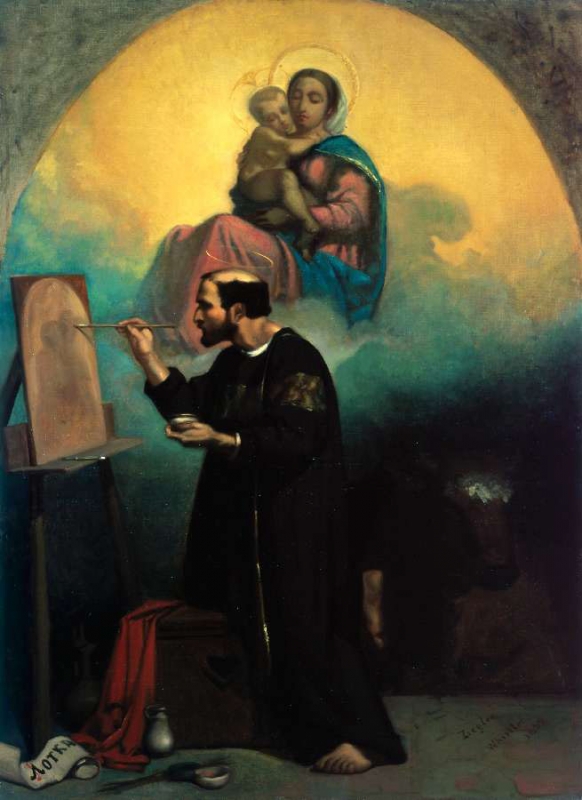Home > Catalogue > People > Warren Adelson (related works) > Catalogue entry
Titles
There are variations on the title as follows:
- 'a picture ... of St. Luke' (1900, Whistler). 1
- 'Copy after Ziegler's 'La Vision de St Luc' (1980, YMSM). 2
- 'Copy of 'The Vision of St Luke' by Jules-Claude Ziegler' (2015, The Hunterian). 3
Copy after Ziegler's 'La Vision de St Luc' is the preferred title.
Description
A vertical figure composition with an arched top. Framed in the arch is the Virgin Mary, sitting among clouds, clad in a pink dress and blue robe. She holds the baby Jesus, who clasps her round the neck, his head snuggling close to hers. The clouds are blue, against a yellow glow of sky. In front, facing left, is a monk in a black robe, bare-footed, painting the mother and child in an arched composition, on a small canvas. All three have halos. He is half kneeling on a box, over which a red robe is draped. He holds a small bowl in his left hand, the brush in his right. There are a couple of bowls and tall jugs in front of him. In the lower left corner is a scroll bearing Greek letters, possibly intended to read Λουκᾶς (Luke).
Sitter
St Luke was one of the Four Evangelists, named as authors of the canonical Gospels of Jesus Christ. Luke came from the Hellenistic city of Antioch in Syria. He became the patron saint of artists, and was said to have painted the portrait of the Virgin Mary and the baby Jesus. The legend goes back to the 8th century, and depictions of the scene are found from the 13th century on. Guilds of St Luke were established for painters and related craftsmen all over Europe. 4
Comments
Pamela Robertson discusses this painting as follows:
'The Evangelist St Luke, patron saint of doctors and artists, is often depicted painting the Virgin Mary, a particularly popular subject in the fifteenth and sixteenth centuries. The distinguished roll call of artists includes Rogier Van der Weyden, Jan Gossaert, Hugo van der Goes. It was a rarer subject in the nineteenth century. Ziegler’s choice fits within the revival of interest in France in religious painting in the early to mid nineteenth century and followed on from his success at the Salon of 1838 with Le Prophète Daniel dans la Fosse aux Lions (Musée de Nantes). St Luc, at nearly three metres high, was a major statement. The original had been acquired from the Paris Salon of 1839 (2140) and most likely went on display in the Luxembourg in 1857 as a tribute to the artist who had died at the end of 1856. Whistler’s selection was therefore of a topical work of art which had been celebrated in its day. Gautier had described it as the happy marriage of a line worthy of Ingres and colour related to Zurbarán. Ziegler and others in Paris were greatly influenced by Spanish painting newly available through private collections such as those of Marshal Jean de Dieu Soult and Alejandro María López as well as Louis-Philippe’s Galerie Espagnole. This formed part of the argument for the acquisition of St Luc for the crown. The work was purchased for 5,000 francs, making it the most expensive painting in the list of purchases for the civil list of 1839.
The painting was transferred by the state to the Musée des Beaux-Arts, Dunkirk in 1872. A smaller version, either a sketch for or after the major work, is held in the Musée Magnin, Dijon, part of the legacy of Maurice Magnin in 1938. A version also appears in pride of place in the late portrait photograph by Félix Nadar, though puzzlingly the composition on the signed print in the Musée d’Orsay is shown in reverse, a probable error in printing. Whistler’s copy is in all respects, bar the omission of a group of attendant putti in the clouds at right and the simplification of the floor tiling, a faithful representation of the original at approximately one third of its scale. (The Odier copy [Whistler's Copy after Odier's 'Episode de la retraite de Moscou' [YMSM 017]] was similarly scaled down making the two comparable in size and suggesting they were conceived as part of a group which would hang together.) …
The group of French copies is in many ways a curiosity in Whistler’s oeuvre. Their subjects – figurative compositions illustrating heroic deeds, military action, religious and mythological subjects – give little hint of what was to follow and show a narrow range, confined mainly to French artists of the eighteenth and nineteenth centuries. The majority, as commissions, were driven by client wishes, though at times Whistler painted for himself.' 5
Whistler's Copy after Odier's 'Episode de la retraite de Moscou' [YMSM 017] at 91.5 x 61.0 cm is slightly smaller than this Copy after Ziegler's 'La Vision de St Luc' [YMSM 015].
Notes:
1: Quoted by Pennell 1921C [more] , p. 171.
2: YMSM 1980 [more] (cat. no. 15).
3: The Hunterian website at http://collections.gla.ac.uk.
4: Howe, Eunice D, 'Luke, St', Grove Art Online, Oxford University Press.
5: P. Robertson 2010 [more] , at pp. 13-14. See also Gautier1839 [more] , at p. 4, who thought the Ziegler to be ‘une des plus belles toiles du salon’. See also Guégan 2003 [more] , at p. 195.
Last updated: 25th November 2020 by Margaret






